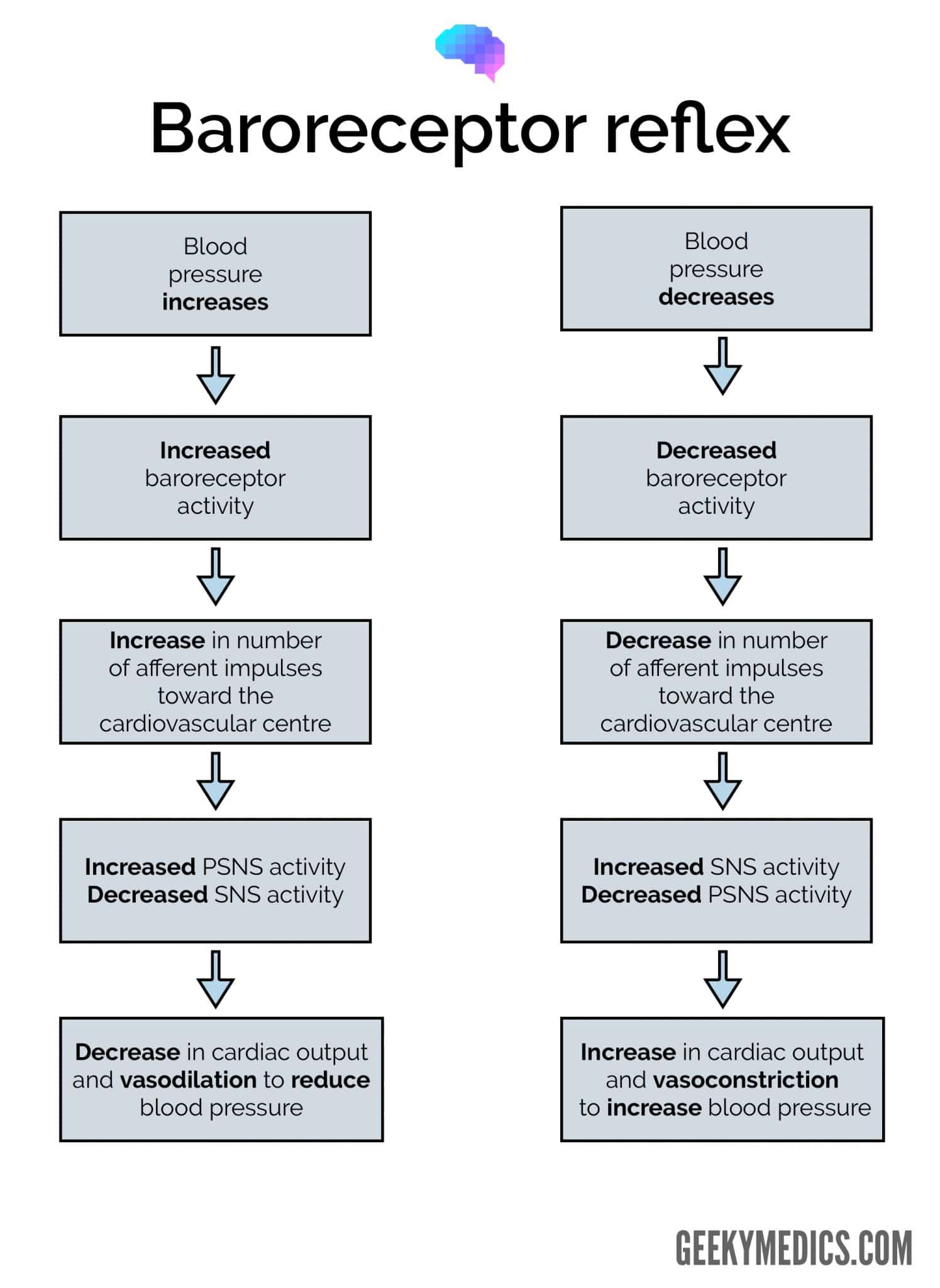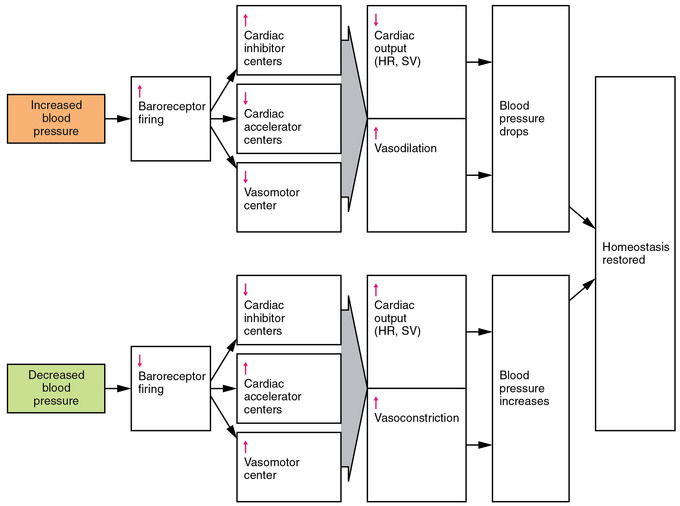Describe the Neural Mechanisms Responsible for Controlling Blood Pressure
Neural endocrine and autoregulatory mechanisms affect blood flow blood pressure and eventually perfusion of blood to body tissues. - located in the pancreatic β-cells on sensory neurons of the vagus nerve in the gastrointestinal tract liver portal vein and the brain several locations httpoutreachmcbharvardeduanimationshomeostasis10swf.

Control Of Blood Pressure Boundless Anatomy And Physiology
The arterial baroreceptor reflex regulates arterial blood pressure.

. These are located in the arch of the aorta and the carotid sinus. First week only 499. Describe the neural mechanisms responsible for controlling blood pressure.
While baroreceptors display the ability to respond to short-term changes in blood pressure the renal mechanisms are responsible for long-term pressure setting. Assignment Instructions 0 Neural endocrine and autoregulatory mechanisms affect blood flow blood pressure and eventually perfusion of blood to body tissues. In addition to the local control of blood flow global control of blood flow including changes in cardiac output and control of arterial BP is mediated by the autonomic nervous system.
What are the general components of a neural reflex controlling bp. Increased arterial pressure stretches the wall of the blood vessel triggering the baroreceptors. Blood pressure varies depending on situation activity and disease states.
Respond to moment-to-moment changes in BP caused. In particular the specific objective of this review is to describe how time and frequency domain analysis of blood pressure and heart rate variability signals permitted to gain new insights onto reflex mechanisms of cardiovascular regulation during exercise without the. Blood Pressure Regulation There are two basic mechanisms for regulating blood pressure.
Regulate vessel diameter heart rate and heart contractility. It is regulated by the nervous and endocrine systems and the kidneys. Solution for Describe the neural mechanisms responsible for controlling blood pressure.
Detector afferent nerve integrating center efferent nerve effector. This brief review addresses current hypotheses concerning the reflex control of circulation during exercise in humans. Of blood pressure relies mainly on neural and humoral mecha-nisms the most rapid of which are the neural mechanisms.
The autonomic nervous system affects the cardiovascular system through the release of epinephrine norepinephrine and acetylcholine. The brain mechanisms regulating cardiovascular and respiratory changes during defensive behavior are complex but the prefrontal cortex amygdala. The cardiovascular center provides a rapid neural mechanism for the regulation of blood pressure by managing cardiac.
Then select one and describe. The following mechanisms help regulate blood pressure. Activation of the cardiostimulatory centre increases myocardial contractility inotropy and HR chronotropy via activation of the sympathetic nervous system SNS 2.
Additionally it has been suggested that central neuronal plasticity associated with the original sino-aortic denervation studies may have confounded some of the original conclusions regarding the autonomic nervous system 42. SYMPATHETIC NEURAL MECHANISMS IN THE REGULATION OF BLOOD PRESSURE. The baroreceptor reflex is a neurally-mediated reflex that regulates blood pressure in the short-term.
The lamina terminalis in the forebrain OVLT SFO and median preoptic nucleus is critical for the regulation of salt and water balance and in the long-term regulation of sympathetic activity and blood pressure. Short-term regulation of blood pressure is controlled by the autonomic nervous system ANS. Start your trial now.
There is a relationship between arterial blood pressure cardiac output and vascular resistance which can be described mathematically and helps us to understand the short-term control of blood pressure in the terms of a hydraulic system. The cardiac center stimulates cardiac output by increasing heart. The neural controls responsible for controlling blood pressure operate via reflex arcs chiefly involving the following components.
Baroreceptors and the associated afferent fibers the vasomotor center of the medulla vasomotor efferent fibers and vascular smooth muscle. Describe the neural mechanisms responsible for. The vasomotor centre has a vasoconstrictor area C-1 containing a high concentration of neurons secreting noradrenaline NA 3.
The sensors in this system are the arterial baroreceptors which mediate changes in the hydraulic system though control of the. Sympathetic neural influences on cardiovascular function can be divided into 4 main categories. Blood pressure is the pressure on the walls of the arteries created by blood as blood is pumped into.
The influences of cardiac sympathetic nerves the influences of vascular sympathetic nerves adrenal medullary influences caused by circulating epinephrine and norepinephrine and. What are the neural reflexes that control blood pressure. Changes in blood pressure are detected by baroreceptors.
Arterial baroreceptor arterial chemoreceptor atrial receptor ventricular receptor cerebral ischemia and cushings reflexes. 0 Select one of the mechanisms in the previous sentence and describe in detail the effects it has on blood flow blood pressure and perfusion. Question Transcribed Image Text.
This reflex is crucial for the maintenance of blood pressure throughout the day and in its absence even a slight change in posture could lead to significant changes in blood pressure. Global neural control of arterial hypertension is essentially. Glucose-sensing neurons sense glucose.
Neural MechanismsThe neural control centers for the regulation of blood pressure are located in the reticular forma-tion of the medulla and lower third of the pons where integra-tion and modulation of autonomic nervous system. Neurohumoral mechanisms regulate blood pressure and blood volume to ensure adequate blood flow for all body organs. The neurological and humoral control of blood pressure are an integrated physiological response which maintains the essential homoeostasis of blood flow to tissues.
Data such as these suggest that autonomic neural mechanisms are important in the control of resting blood pressure in humans. Short-Term Regulation of Blood Pressure. Neural mechanisms include the cardiovascular centers in the medulla oblongata baroreceptors in the aorta and carotid arteries and right atrium and associated chemoreceptors that monitor blood levels of oxygen carbon dioxide and.

Regulation Of Blood Pressure Physiology Geeky Medics

Control Of Blood Pressure Boundless Anatomy And Physiology

Homeostatic Regulation Of The Vascular System Anatomy And Physiology Ii
Belum ada Komentar untuk "Describe the Neural Mechanisms Responsible for Controlling Blood Pressure"
Posting Komentar